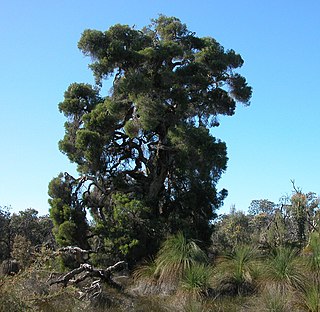
Melaleuca preissiana, commonly known as stout paperbark, modong or moonah, is a plant in the myrtle family, Myrtaceae and is endemic to coastal areas of southwest Australia. It is a shrub or small tree with papery bark, small leaves and spikes of usually white flowers. It occurs chiefly in areas that are seasonally wet.

Melaleuca borealis is a plant in the myrtle family, Myrtaceae and is endemic to areas in the tropical north of Queensland. It has relatively long, thin, cylinder-shaped leaves and heads of white to pale yellow flowers on the ends of its branches in late spring.

Melaleuca croxfordiae is a plant in the myrtle family, Myrtaceae and is endemic to the far south-west of corner Western Australia. It is a paperbark, usually growing in winter-wet places, with long, narrow leaves and a few small creamy coloured flower heads in early summer.

Melaleuca hnatiukii is a plant in the myrtle family, Myrtaceae and is endemic to the south of Western Australia. It is a medium to large shrub with arching branches, prickly tipped leaves and creamy-white heads of flowers in spring or early summer.

Melaleuca johnsonii is a plant in the myrtle family, Myrtaceae and is endemic to the south of Western Australia. It is similar to Melaleuca thapsina with its cylindrical leaves with prickly tips and usually yellow heads of flowers but is distinguished from it by its shorter leaves and papery sepals.
Melaleuca keigheryi is a shrub in the myrtle family, Myrtaceae with white, papery bark and is endemic to the west coast of Western Australia. In spring, it has heads of pink flowers which fade in color to become white.

Melaleuca squamophloia is a plant in the myrtle family, Myrtaceae and is endemic to the black soil plains of south eastern Queensland in Australia. Like its close relative Melaleuca styphelioides, it is a small, erect tree with prickly leaves and spikes of cream or white flowers but its bark is hard rather than papery and the leaves have fewer veins than that species.
Melaleuca clarksonii, commonly known as Alice River bottlebrush, is a plant in the myrtle family, Myrtaceae and is endemic to Cape York Peninsula in Queensland, Australia. It is similar to Melaleuca cajuputi and Melaleuca leucadendra with its broad leaves and spikes of creamy-coloured flowers but is distinguished from them by its (usually) hard, fibrous bark.
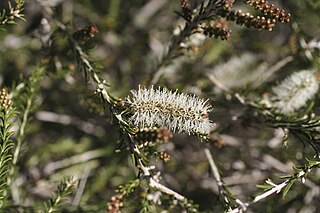
Melaleuca adnata, commonly known as sandhill honey-myrtle, is a plant in the myrtle family, Myrtaceae and is endemic to the south-west of Western Australia. It is a tall shrub with papery bark and spikes of white flowers in spring and early summer.
Melaleuca xerophila is a shrub or small tree in the myrtle family Myrtaceae and is native to arid parts of South Australia and Western Australia. It is a large shrub with narrow leaves and heads of white or cream-coloured flowers in spring.
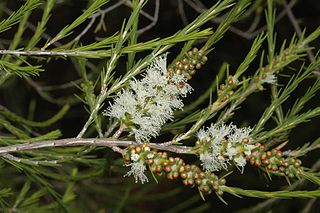
Melaleuca densispicata is a plant in the myrtle family Myrtaceae and is native to Queensland and New South Wales in Australia. It is a dense, woody shrub or tree with papery or scaly bark, sharp pointed leaves and dense flower spikes. It is uncommon throughout its range and was not formally described until 1984.
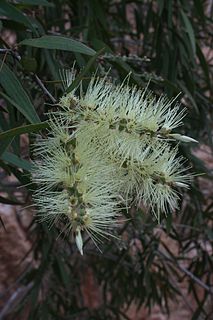
Melaleuca fluviatilis is a plant in the myrtle family, Myrtaceae and is endemic to northern Queensland in Australia. It is a tree with papery bark, narrow leaves and spikes of white or creamy-coloured flowers, usually growing along streams and rivers. It is common in tropical areas and is sometimes confused with Melaleuca argentea although it lacks that species' silvery foliage.
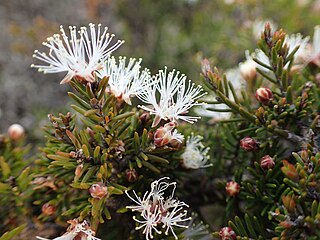
Melaleuca haplantha is a shrub in the myrtle family, Myrtaceae and is endemic to the south-west of Western Australia. It was first described as a new species in 1988 when Bryan Barlow undertook a review of Melaleuca cuticularis and found it to include 13 separate species.

Melaleuca pomphostoma is a plant in the myrtle family, Myrtaceae, and is endemic to the south-west of Western Australia. It is a small, dense shrub with fleshy, narrow leaves, greenish-yellow flowers. It is similar and closely related to Melaleuca bracteosa but differs in the colour and number of stamens in each flower.
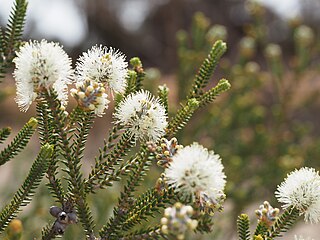
Melaleuca quadrifaria, commonly known as limestone honey-myrtle, is a plant in the myrtle family, Myrtaceae, and is native to the south of Western Australia. It is distinguished by the small size and arrangement of its leaves combined with its small spikes of white or cream flowers.

Melaleuca spathulata is a shrub in the myrtle family, Myrtaceae, and is endemic to the south-west of Western Australia. It is a well known garden shrub featuring dark green leaves against light-coloured foliage, many twisted branches and profuse heads of bright pink "pom pom" flower heads in spring or early summer.

Melaleuca stenostachya, commonly known as fibre-barked teatree or straight teatree is a plant in the myrtle family Myrtaceae and is native to the Cape York Peninsula in northern Australia, the gulf country of the Northern Territory and the south of Papua New Guinea. It is closely related to Melaleuca dealbata but can be distinguished from that species by the wide separation of the flowers in the inflorescence.
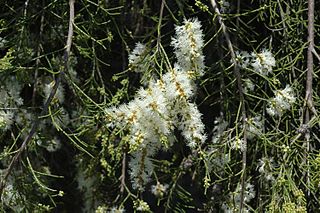
Melaleuca tamariscina, commonly known as bush-house paperbark or tamarix honey-myrtle is a plant in the myrtle family, Myrtaceae and is endemic to central Queensland in Australia. It grows to the height of a small tree with small, scale-like leaves that are pressed against the branches, and has a papery bark and a weeping habit.

Melaleuca teuthidoides is a plant in the myrtle family, Myrtaceae and is endemic to the south of Western Australia. It is a shrub with rough bark and heads of white flowers on the ends of its branches in spring and early summer.

Melaleuca serpentina is a plant in the myrtle family, Myrtaceae and is endemic to the Barraba district in Australia. It is a shrub with yellow or creamy-green bottlebrush flowers. It is similar to Melaleuca citrina but can be distinguished from that species by its flower colour and its shorter stamens.



















